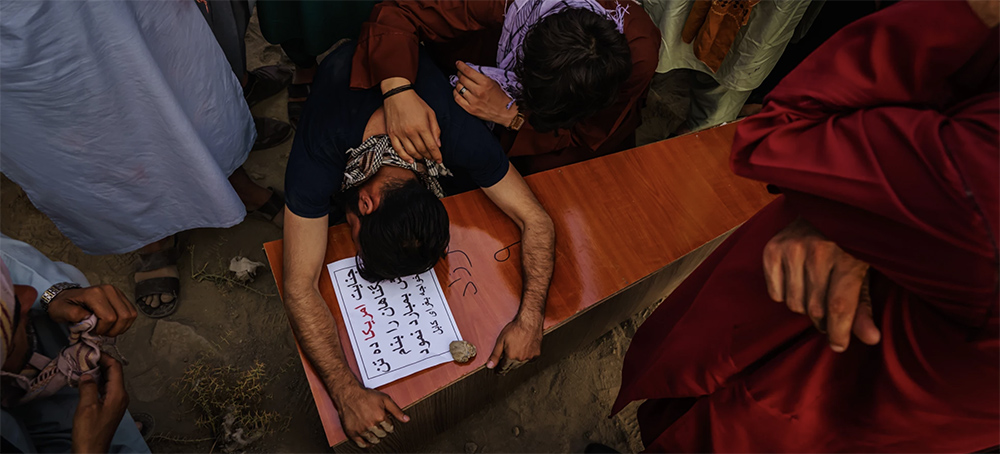Independence and the Lifeline of Public Funding
Without corporate funding public support is not just important — it is a lifeline. With a small contribution you can insure that there will be a powerful independent presence in the news cycle.
Risk a few dollars, it’s well worth it.
Marc Ash
Founder, Reader Supported News
If you would prefer to send a check:
Reader Supported News
PO Box 2043 / Citrus Heights, CA 95611
Follow us on facebook and twitter!
Live on the homepage now!
Reader Supported News
The article below is satire. Andy Borowitz is an American comedian and New York Times-bestselling author who satirizes the news for his column, "The Borowitz Report."
A T.S.A. agent at Reagan National Airport, Harland Dorrinson, explained how Bannon’s talent as a master of disguise nearly enabled him to board a plane to Moscow.
“He showered, shaved, and even combed his hair,” Dorrinson said. “He was totally unrecognizable.”
Bannon’s plan crumbled, however, during a routine pat down. “That’s when we noticed that his pants had a large mustard stain,” the T.S.A. agent said. “They evidently had not been laundered in months. One of my colleagues shouted, ‘It’s Bannon! Stop him!’ ”
Taken into custody, the former White House adviser seemed bitter about his foiled escape attempt. “I took a shower for no fucking reason,” he said.
 A relative throws himself and weeps over the casket of Farzad, 12, who was killed by U.S. drone airstrikes, according to his family, in Kabul, Afghanistan. (photo: Marcus Yam/LA Times)
A relative throws himself and weeps over the casket of Farzad, 12, who was killed by U.S. drone airstrikes, according to his family, in Kabul, Afghanistan. (photo: Marcus Yam/LA Times)
Two new books shed light on what remote warfare does to military operators, the standing of the U.S., and societies abroad.
A series of innocuous actions, like Ahmadi loading water containers into his car, were interpreted in the minds of the operators watching as sinister preparations for a suicide bomb attack. After surveilling Ahmadi for several hours, the drone operators issued a death sentence, firing a Hellfire missile at his car as he drove up to his home, just as three children were rushing out to greet him. A total of 10 people, all civilians, were killed in the attack that the U.S. military had initially insisted had targeted a terrorist working with the Islamic State.
The deaths of Ahmadi and his family members were unique in the level of public attention they received. It was sadly unremarkable, though, in the context of the larger U.S. drone war that has been waged over the past 20 years.
Armed drones have become a staple of modern American warfare, placing operators at a historically unprecedented remove from danger. At the same time, they have exposed those targeted, whether combatants or civilians, to a form of violence that they can neither defend themselves against nor surrender to. Freed from the traditional reciprocity of war, in which both sides put their lives on the line, drone operators have become more like judicial executioners: putting people on trial on the other side of the planet without due process and meting out death sentences by remote control.
The U.S. pioneered this style of warfare but is no longer alone in using what are technically called unmanned aerial vehicles, or UAVs. Other countries, including U.S. rivals, are ramping up their own drone programs, signaling that this style of killing at great distance is likely to become a defining feature of war in the 21st century.
Understanding what this means is the task of two recent books, “Asymmetric Killing: Risk Avoidance, Just War, and the Warrior Ethos” by Neil Renic, an international relations scholar at the Institute for Peace Research and Security Policy at the University of Hamburg in Germany, and “On Killing Remotely: The Psychology of Killing With Drones,” by Wayne Phelps, a retired U.S. Marine Corps lieutenant colonel who participated in the wars in Iraq and Afghanistan.
Phelps’s book is based on hundreds of interviews with drone operators who have carried out strikes. Examining how drone warfare fits into the broader culture of the U.S. military, the volume also gives a remarkable insight into the psyche of drone operators tasked with carrying out targeted killings. Unlike traditional forms of combat where events often move with brutal speed, drone operators, through a high-definition camera in the sky, often intimately follow their targets over long periods of time, sometimes several months, getting to know their habits, personalities, and even families, before one day pulling the trigger and killing them.
While drone strikes are often viewed as an antiseptic, dehumanized form of killing — comparable to blowing up targets in a video game — many operators interviewed by Phelps describe it as a psychologically difficult. Some even develop parasocial relationships with those they are tasked to stalk and kill.
In one case discussed in the book, an intelligence analyst working on the CIA’s drone program was part of a team tasked with six months of 24-hours-a-day surveillance of a man said to be a “high-value target.” In addition to the behavior that was alleged to justify his killing, the analyst observed his target walking his children to school on a daily basis and taking care of his family, as part of a long-term surveillance routine known as pattern-of-life analysis. In a strange way, the analyst got to know his target, even developing a level of sympathy born out of spending so much time seeing how he interacted with others, especially his wife and children.
Eventually, the day that the intelligence analyst would have to kill him came. After such a long period of voyeuristic intimacy with the man — about whom the analyst himself said, “there was no doubt that he was a good father” — it was nothing like a video game. A father himself, the analyst related on a human level with the man he had been following. In many ways, the level of closeness and knowledge about his target, gleaned by watching him for months through a drone’s lens, was far greater than that in traditional combat situations, where combatants have little personal knowledge about those that they kill. As Phelps notes, “the analyst said that when the time came to strike this guy, whom he had observed being a normal dad every day for six months, it was emotionally difficult.”
Other drone operators describe experiencing physiological stress during their missions, as well as brief bursts of adrenaline following successful shots that supported friendly ground forces engaged in active combat. When they were asked to describe their worst day on the job, many of their responses dealt with what drone crews saw in the aftermath of certain strikes. One sensor operator on a drone described their worst day to Phelps this way: “Watching the son of the person I just obliterated with a Hellfire missile pick up the pieces of his father. It wasn’t the act of killing I focused on, it was watching the boy’s face and interactions with the rest of his family that continue to haunt me.”
A contractor working as a tactical controller on a Reaper drone crew also provided their view on the long-term consequences of a killing that he had helped carry out:
Although I would not do it differently, conducting surveillance on a confirmed HVT [high-value target] and seeing him positively interact with his spouse and children, like a caring father and husband, playing soccer with his son, and ultimately taking a kinetic strike opportunity far from his home. No collateral damage occurred, however, had full viewing in HD of the family mourning and could not help but think that the son would be the next generation of terrorist due to this event.
Phelps approaches drone warfare as a military insider. He is mainly concerned with reducing the stigma against drone operators within the military hierarchy and finding ways of making the process of remote killing psychologically easier. He suggests creating greater social distance between operator and target, using technical language to describe the people involved, and breaking up tasks so that the person doing intimate, pattern-of-life surveillance on an individual is not the same person pulling the trigger or observing the target’s family in grief in the aftermath.
Not everyone who takes part in drone warfare is troubled by their experience. Some take the righteousness of their operations for granted. Nonetheless, in his descriptions of the psychological impact of targeted killing on drone operators, Phelps dispels the notion that taking a life with a drone is always as easy as playing a video game for the people doing it.
“It’s ridiculous the idea that we don’t see the humanity. I’m watching a target for eight hours. I’m going to watch him go to the store and go to his wife. I’ve had targets that I followed for four or five days. I know where they live, I know what they do,” one drone operator told Phelps. “Then eventually you kill this guy. Absolutely I know that his wife is out there and that we just made her a widow and that we just took a father away from his three kids. It sucks. I wish it was just a guy in a car that we didn’t know. Those shots are easy.”
Embedded in Phelps’s analysis in “On Killing Remotely” is the assumption that targeted killing with drones is just another evolution in how human beings have created advantages for themselves in combat, comparable to the bow and arrow, cannon, sniper rifle, bomber plane, and ballistic missile.
That assumption is put to the test in Neil Renic’s “Asymmetric Killing.” Renic argues that drones establish a “radical asymmetry” of violence unlike anything created by prior weapons. The utter lopsidedness of the violence, where one side is completely free from danger and the other at their total mercy, calls into question whether what is happening is a war at all — or something more sinister.
In countries like Pakistan, Yemen, and Somalia, the U.S. has carried out thousands of strikes in the absence of a meaningful U.S. ground presence. The people being killed on the ground in these strikes usually do not, and indeed cannot, pose any conceivable threat to Americans. Renic argues, with reference to philosophical traditions like “just war” theory, that this makes even many purportedly legitimate drone targets, particularly the low-level, rural, foreign fighters who bear the brunt of the drone program, little different from civilians.
The concept of war as a legal and morally regulated activity was historically built on an assumption of mutual risk and danger among those taking part. That dynamic simply no longer exists when one side is fighting only with robots from the other side of the planet. While prior technological advances may have reduced the structural threat between combatants, drone warfare is the first time that one side has made themselves absolutely immune to violence.
“UAV-exclusive violence marks a fundamental shift in the nature of hostilities, from an adversarial contestation to something more closely approximating judicial sanction,” Renic writes. “One outcome of this shift has been the dehumanization of those targeted by the United States.”
What emerges in place of war as a situation of mutual risk is simply an unending series of executions carried out from the skies. The task of the people carrying out many strikes is less about overcoming an enemy in battle than issuing moral judgments and death sentences against individuals who pose no conceivable threat to the U.S. and whose customs, circumstances, and even identities are often unknown to them. To use a chilling metaphor, Renic argues that killing through drone strikes outside of active combat situations is less like war, as traditionally defined, and more like “a creative process of disinfection.”
In cases where drones are targeting high-level terrorists who are directly planning attacks against the U.S. or where they are supporting friendly ground forces in combat, the strikes are more justifiable, according to traditional moral schema. These are not often the circumstances of drone strikes. Thousands of strikes have taken place outside of active combat zones over the years or have targeted low-level fighters or even unarmed individuals who posed no direct threat to U.S. forces or civilians. An investigative report recently published by the military-focused news site Connecting Vets, including leaked footage of many strikes, outlined the extent to which U.S. military commanders became obsessed with killing low-level suspected Taliban members in Helmand Province, Afghanistan, during a 2019 drone campaign.
Fixated on increasing their “kill counts” as a metric of operational success, military commanders authorized drone strikes even against unarmed individuals in the province suspected of having walkie-talkies or wearing tactical vests. The attacks were in stark contrast to Phelps’s characterization of U.S. drone warfare as intelligence-driven, targeted strikes against bad actors: Participants in the Helmand campaign described it as “nihilistic,” stating that “the drone strikes were punitive. Killing for the sake of killing.”
As much as drone warfare has eliminated mortal risk on one side of war almost entirely, it has simultaneously displaced that risk onto civilians whose safety the military is ostensibly tasked to defend. By making themselves wholly immune to retributive violence from an enemy that they kill from afar, the U.S. military makes it more likely that those enemies will respond by attacking whatever target is available, usually civilian ones, rather than accept surrender or annihilation in the face of relentless one-way violence.
That does not make the killing of civilians, whether Americans or locals in foreign countries, by militant groups any less morally objectionable. Yet by military officials’ own accounts, the displacement of the violence onto the defenseless is a foreseeable outcome of policies that primarily seek to protect soldiers from physical danger at all costs.
“Attempts to armorize our force against all potential enemy threats … shifts the ‘burden of risk’ from a casualty-averse military force onto the populace,” wrote American Marine Maj. Trent Gibson in a 2009 paper titled “Hell Bent on Force Protection: Confusing Troop Welfare with Mission Accomplishment in Counterinsurgency,” which drew on experiences in Iraq and Afghanistan. “In doing so, we have lifted the burden from our own shoulders and placed it squarely upon those who do not possess the material resources to bear it — the civilian populace.”
“On Remote Killing” ends with a word of warning about the prospect of autonomous weapons platforms, which may have the capacity of distancing human beings from war even further by automating the entire killing process using artificial intelligence. Phelps compellingly argues that “war is a human endeavor and there must be a human cost to undertaking it.” Though his book establishes that taking lives is not as easy for drone operators as stereotypes may suggest, for those who have been on the receiving end of violence over the past 20 years, simply knowing that there is a human being who pulled the trigger that killed their family members is not much comfort.
After initially trying to cover up the killings of Zemari Ahmadi and his family in Kabul, the Pentagon subsequently backtracked following a stream of news reports disproving their narrative about killing an ISIS-K terrorist, the Islamic State group’s affiliate in Afghanistan. Though it was forced to admit responsibility, the military has said that no disciplinary action would be taken against anyone involved in the attack that took the lives of 10 members of an innocent family.
If drone warfare, whether autonomous or not, is to have any moral component at all, it must include some accountability for the innocent people regularly killed in strikes like the one that ended the life of Zemari Ahmadi. Periodic apologies aside, moral responsibility toward the tens of thousands killed, maimed, or deprived of their loved ones over the past 20 years has been in short evidence.
“That is not enough for us to say sorry,” Emal Ahmadi, Zemari’s brother, told reporters in the aftermath of the drone strike. “The U.S.A. can see from everywhere. They can see that there were innocent children near the car and in the car. Whoever did this should be punished. It isn’t right.”
 Ron DeSantis. (photo: Joe Raedle/Getty Images)
Ron DeSantis. (photo: Joe Raedle/Getty Images)
Biden and the Democrats need to step up their efforts to stop these irresponsible death-cultists.
But on Thursday, DeSantis called for a special session of the state legislature, which will cost Florida taxpayers $1 million, to oppose the federal mandate and punish businesses with vaccine mandates, recommending they be held liable if a worker has an “adverse reaction.” He also said these businesses will no longer qualify for COVID-19 liability protection. One might think that “death” is the worst “adverse reaction” to a pandemic that has killed more than 700,000 Americans, but GOP leaders won’t let the Grim Reaper deter their endless culture war to rally their radicalized base and take back political power in 2022.
DeSantis tweeted that “no one should lose their job over a COVID shot,” but he seems less concerned with Floridians losing their lives over COVID. His state had more deaths than any other during the Delta variant spike this summer, and altogether over 58,000 people in his state have died so far from the virus. Unfortunately, it seems DeSantis, who is allegedly “pro-life,” cares more about his political future, softball interviews on Fox News, and the supposed rights of selfish and reckless pro-death GOP voters to spread the virus and kill the elderly and immunocompromised before Christmas.
DeSantis, who is vaccinated, is also apparently fine with anti-vax disinformation. Florida’s dangerous new surgeon general, Dr. Joseph Ladapo, whom the Orlando Sentinel’s editorial board described as a “well educated COVID crank,” joined DeSantis at his press conference where he questioned the efficacy of COVID-19 vaccines. He also denounced all workplace mandates. Instead, the governor now urges that people simply “stick with ther intuition and their sensibilities.” Those “intuition” and “sensibilities” have led to a shortage of ivermectin, a deworming drug that hasn’t been proven to help cure COVID but has now poisoned many Republicans.
This madness is just a sneak preview of the all-out obstruction by the GOP and its base once the FDA approves vaccines for children ages 5 to 12. The Biden Administration’s plan to vaccinate 28 million children includes making the shots available at doctor’s offices, local pharmacies, and potentially even schools, which have become ground zero for an aggressively anti-democratic GOP base culture war attacking CRT, transgender rights, and masks.
What happens if schools follow California’s lead and require vaccines? In normal times, this wouldn’t be a controversy considering schools already require children to be vaccinated against smallpox, polio, measles and rubella. But thanks to a radicalized GOP base, the National School Board Association, which represents more than 90,000 school board members in 14,000 public school districts across the nation, was forced to ask President Biden for help and protection. In a September letter, the association cited more than 20 detailed instances of threats, harassment and initmidation from this “angry mob” and said these incidents are “the equivalent to a form of domestic terrorism and hate crimes.”
Attorney General Merrick Garland responded by ordering the FBI to work with local leaders to look into a “disturbing spike in harassment, intimidation, and threats of violence” against teachers and school board members simply trying their best to protect children during a deadly pandemic. Republicans, however, have lost interest in law and order—and have also lost their minds. On Thursday, Garland defended his decision in front of the House Judiciary Committee Oversight Hearing where he was grilled by Rep. Jim Jordan, who accused Garland and the Justice Department of creating a “snitch line on parents.” Jordan, of course, never snitches, especially when it comes to Trump or sexual abusers.
Not to be outdone, DeSantis defied the order, and earlier this week tweeted that Garland is “weaponizing the Department of Justice against everyday parents trying to raise their kids.” Without a trace of self-awareness, DeSantis also tweeted, “we should encourage parental engagement in a child’s education—not use intimidation tactics to try and prevent it.” This is coming from the same man who just called for a special session to punish businesses that implement private vaccine mandates. Earlier in the summer, DeSantis threatened to withhold the salary of superintendents who didn’t obey his mask bans. The Florida Health Department this week just fined Leon County over $3.5 million. Why? Because the Florida county violated the state’s insane new anti vax passports law that DeSantis signed in May, which bans local governments from requiring any person to provide proof of vaccination and levies fines of $5,000 for each violation. Hypocrisy and projection, thy name is DeSantis.
As I’ve written before, we cannot win over a pro-death cult. I’m tired of bending the knee to violent, ideological extremists and being hijacked by their white rage, economic anxiety, delusional conspiracy theories, and perpetual sense of victimhood. Their selfish actions are jeopardizing our children’s lives during an ongoing pandemic.
President Biden and Democrats, who represent the majority in this country, need to hold the line and continue promoting vaccine mandates, which have proven to be both successful and popular. According to legal experts, President Biden has the authority to impose vaccine requirements on the private sector “through laws that require businesses to comply with evidence-based federal health safety standards.” Specifically, the Labor Secretary has the authority to issue an emergency temporary standard if it is determined workers “face grave danger from exposure to substances or agents determined to be toxic or physically harmful or from hazards.” COVID, which has killed over 700,000, seems to fit the definition of a “toxic” substance.
Biden must continue using the presidential pulpit to call out Republican governors like DeSantis and Abbott of Texas by name for their failed leadership that has resulted in thousands of preventable deaths. I know Republicans are impervious to shame, but Biden’s audience is the majority that wants Democratic leadership to flex their powers and hold these agents of chaos publicly accountable for their misdeeds.
If it’s litigation GOP wants, then two can play at that game. Businesses and school districts need to fight back in court to protect their rights from Republican intimidation and overreach. Vincent Long, an Administrator from Leon County, which was just fined by Florida, responded by saying his county believes its vaccination requirement is “legally justifiable.” Earlier this week, a trial began in which six Florida school districts challenged the Florida Department of Health’s ban on masks in schools. It’s possible the court finds that DeSantis’ measures violated the Florida Constitution by endangering the health of school children, staff and workers.
Finally, Garland needs to unleash The Department of Justice and consider criminal investigations if Republican anti-mask and anti-vaccine policies have misrepresented information in a way that actively led to deaths across the nation. Prosecutorial authorities at the federal, state and local levels should be encouraged to hold elected individuals accountable.
At the very least, Garland defending his call to mobilize the FBI to protect school boards and teachers against the threat of violence is an excellent indication that he won’t be swayed by Republican pressure. Now, the Justice Department needs to drop the hammer. Whether it’s a Republican governor or a right-wing activist, people who threaten and harm the public, especially our teachers and school children, should be prosecuted and stopped. Enough is enough. No one is above the law.
In Florida, all you have to do is follow the facts. It will take you to the graveyard where you’ll find 58,000 tombstones—and counting.
 The Pride parade in Madrid in June. (photo: Rodrigo Jimenez/EPA)
The Pride parade in Madrid in June. (photo: Rodrigo Jimenez/EPA)
Increasingly, authoritarians are likening ‘genderism’ to ‘communism’ and ‘totalitarianism’
The attacks on so-called “gender ideology” have grown in recent years throughout the world, dominating public debate stoked by electronic networks and backed by extensive rightwing Catholic and evangelical organizations. Although not always in accord, these groups concur that the traditional family is under attack, that children in the classroom are being indoctrinated to become homosexuals, and that “gender” is a dangerous, if not diabolical, ideology threatening to destroy families, local cultures, civilization, and even “man” himself.
It is not easy to fully reconstruct the arguments used by the anti-gender ideology movement because they do not hold themselves to standards of consistency or coherence. They assemble and launch incendiary claims in order to defeat what they see as “gender ideology” or “gender studies” by any rhetorical means necessary. For instance, they object to “gender” because it putatively denies biological sex or because it undermines the natural or divine character of the heteronormative family. They fear that men will lose their dominant positions or become fatally diminished if we start thinking along gender lines. They believe that children are being told to change genders, are actively recruited by gay and trans people, or pressured to declare themselves as gay in educational settings where an open discourse about gender is caricatured as a form of indoctrination. And they worry that if something called “gender” is socially accepted, a flood of sexual perversities, including bestiality and pedophilia, will be unleashed upon the earth.
Although nationalist, transphobic, misogynist, and homophobic, the principal aim of the movement is to reverse progressive legislation won in the last decades by both LGBTQI and feminist movements. Indeed, in attacking “gender” they oppose reproductive freedom for women and the rights of single parents; they oppose protections for women against rape and domestic violence; and they deny the legal and social rights of trans people along with a full array of legal and institutional safeguards against gender discrimination, forced psychiatric internment, brutal physical harassment and killing. All this fervor ramped up during a pandemic time in which domestic abuse has soared and queer and trans kids have been deprived of their spaces for gathering in life-supporting communities.
It is easy enough to debunk and even ridicule many of the claims that are made against gender studies or gender identity, since they are based on thin caricatures, and often verge on the phantasmagoric. If it matters (and let’s hope it still does), there is no one concept of gender, and gender studies is a complex and internally diverse field that includes a wide range of scholars. It does not deny sex, but it does tend to ask about how sex is established, through what medical and legal frameworks, how that has changed through time, and what difference it makes to the social organization of our world to disconnect the sex assigned at birth from the life that follows, including matters of work and love.
We generally think of sex assignment as happening once, but what if it is a complex and revisable process, reversible in time for those who have been wrongly assigned? To argue this way is not to take a position against science, but only to ask how science and law enter into the social regulation of identity. “But there are two sexes!” Generally, yes, but even the ideals of dimorphism that govern our everyday conceptions of sex are in many ways disputed by science as well as the intersex movement, which has shown how vexed and consequential sex assignment can be.
To ask questions about gender, that is, how society is organized according to gender, and with what consequences for understanding bodies, lived experience, intimate association, and pleasure, is to engage in a form of open inquiry and investigation, opposing the dogmatic social positions that seek to stop and reverse emancipatory change. And yet, “gender studies” is opposed as “dogma” by those who understand themselves on the side of “critique”.
One could go on at length to explain the various methodologies and debates within gender studies, the complexity of scholarship, and the recognition it has received as a dynamic field of study throughout the world, but that would require a commitment to education on the part of the reader and listener. Given that most of these opponents refuse to read any material that might contradict their beliefs or cherrypick from complex texts to support a caricature, how is one to proceed?
Still others claim that the very concept of “gender” is an attack on Christianity (or, in some countries, traditional Islam), and accuse the proponents of “gender” of discriminating against their religious beliefs. And yet, the significant field of gender and religion suggests that the enemies do not come from the outside, and that the dogma is to be found on the side of the censors.
For this reactionary movement, the term “gender” attracts, condenses, and electrifies a diverse set of social and economic anxieties produced by increasing economic precarity under neoliberal regimes, intensifying social inequality, and pandemic shutdown. Stoked by fears of infrastructural collapse, anti-migrant anger and, in Europe, the fear of losing the sanctity of the heteronormative family, national identity and white supremacy, many insist that the destructive forces of gender, postcolonial studies, and critical race theory are to blame. When gender is thus figured as a foreign invasion, these groups clearly reveal that they are in the business of nation-building. The nation for which they are fighting is built upon white supremacy, the heteronormative family, and a resistance to all critical questioning of norms that have clearly restricted the freedoms and imperiled the lives of so many people.
The vanishing of social services under neoliberalism has put pressure on the traditional family to provide care work, as many feminists have rightly argued. In turn, the fortification of patriarchal norms within the family and the state has become, for some, imperative in the face of decimated social services, unpayable debt, and lost income. It is against this background of anxiety and fear that “gender” is portrayed as a destructive force, a foreign influence infiltrating the body politic and destabilizing the traditional family.
Indeed, gender comes to stand for, or is linked with, all kinds of imagined “infiltrations” of the national body – migrants, imports, the disruption of local economics through the effects of globalization. Thus “gender” becomes a phantom, sometimes specified as the “devil” itself, a pure force of destruction threatening God’s creation (not, I gather, climate change, which would be a much more likely candidate). Such a phantasm of destructive power can only be subdued through desperate appeals to nationalism, anti-intellectualism, censorship, expulsion, and more strongly fortified borders. One reason, then, we need gender studies more than ever is to make sense of this reactionary movement.
The anti-gender ideology movement crosses borders, linking organizations in Latin America, Europe, Africa, and east Asia. The opposition to “gender” is voiced by governments as diverse as Macron’s France and Duda’s Poland, circulating in rightwing parties in Italy, showing up on major electoral platforms in Costa Rica and Colombia, boisterously proclaimed by Bolsonaro in Brazil, and responsible for closing gender studies in several locations, most infamously at the European University in Budapest in 2017 before it relocated to Vienna.
In Germany and throughout eastern Europe “genderism” is likened to “communism” or to “totalitarianism”. In Poland, more than one hundred regions have declared themselves “anti-LGBT zones”, criminalizing an open public life for anyone perceived as belonging to those categories, forcing young people to leave the country or go underground. These reactionary flames have been fanned by the Vatican, which has proclaimed “gender ideology” “diabolical”, calling it a form of “colonizing imperialism” originating in the north and raising fears about the “inculcation” of “gender ideology” in the schools.
According to Agnieszka Graff, co-author with Elzbieta Korolczuk of Anti-Gender Politics in the Populist Moment, the networks amplifying and circulating the anti-gender viewpoint include the International Organization for the Family, which boasts thousands of participants at its conferences and the online Platform CitizenGo, founded in Spain, which mobilizes people against lectures, exhibitions, and political candidates who defend LGBTQI rights. They claim to have more than 9 million followers, ready to mobilize at an instant (they mobilized against me in Brazil in 2018 when a furious crowd burned the effigy of my “likeness” outside the venue where I was to speak). The third is Agenda Europe, consisting of more than 100 organizations, which casts gay marriage, trans rights, reproductive freedom, and LGBTQI anti-discrimination efforts as assaults on Christianity.
Anti-gender movements are not just reactionary but fascist trends, the kind that support increasingly authoritarian governments. The inconsistency of their arguments and their equal opportunity approach to rhetorical strategies of the left and right, produce a confusing discourse for some, a compelling one for others. But they are typical of fascist movements that twist rationality to suit hyper-nationalist aims.
They insist that “gender” is an imperialist construct, that it is an “ideology” now being imposed on local cultures of the global south, spuriously drawing on the language of liberation theology and decolonial rhetoric. Or, as the rightwing Italian group Pro Vita maintains, “gender” intensifies the social effects of capitalism whereas the traditional heteronormative family is the last bulwark against social disintegration and anomic individualism. All this seems to follow from the very existence of LGBTQI people, their families, marriages, intimate associations, and ways of living outside the traditional family and their rights to their own public existence. It follows as well from feminist legal claims to reproductive freedom, feminist demands to end sexual violence as well as the economic and social discrimination against women.
At the same time, opponents of “gender” seek recourse to the Bible to defend their views about the natural hierarchy between men and women and the distinctive values of masculine and feminine (although progressive theologians have pointed out that these are based on debatable readings of biblical texts). Assimilating the Bible to natural law doctrine, they claim that assigned sex is divinely declared, suggesting that contemporary biologists and medical doctors are curiously in the service of 13th-century theology.
It does not matter that chromosomal and endocrinological differences complicate the binarism of sex and that sex assignment is revisable. The anti-gender advocates claim that “gender ideologists” deny the material differences between men and women, but their materialism quickly devolves into the assertion that the two sexes are timeless “facts”. The anti-gender movement is not a conservative position with a clear set of principles. No, as a fascist trend, it mobilizes a range of rhetorical strategies from across the political spectrum to maximize the fear of infiltration and destruction that comes from a diverse set of economic and social forces. It does not strive for consistency, for its incoherence is part of its power.
In his well-known list of the elements of fascism, Umberto Eco writes, “the fascist game can be played in many forms,” for fascism is “a collage … a beehive of contradictions”. Indeed, this perfectly describes anti-gender ideology today. It is a reactionary incitement, an incendiary bundle of contradictory and incoherent claims and accusations. They feast off the very instability they promise to contain, and their own discourse only delivers more chaos. Through a spate of inconsistent and hyperbolic claims, they concoct a world of multiple imminent threats to make the case for authoritarian rule and censorship.
This form of fascism manifests instability even as it seeks to ward off the “destabilization” of the social order brought about by progressive politics. The opposition to “gender” often merges with anti-migrant furor and fear, which is why it is often, in Christian contexts, merged with Islamophobia. Migrants, too, are figured as “infiltrating”, engaging in “criminal” acts even as they exercise their rights of passage under international law. In the imaginary of the anti-gender ideology advocates, “gender” is like an unwanted migrant, an incoming stain, but also, at the same time, a colonizer or totalitarian who must be thrown off. It mixes right and left discourses at will.
As a fascist trend, the anti-gender movement supports ever strengthening forms of authoritarianism. Its tactics encourage state powers to intervene in university programs, to censor art and television programming, to forbid trans people their legal rights, to ban LGBTQI people from public spaces, to undermine reproductive freedom and the struggle against violence directed at women, children, and LGBTQI people. It threatens violence against those, including migrants, who have become cast as demonic forces and whose suppression or expulsion promises to restore a national order under duress.
That is why it makes no sense for “gender critical” feminists to ally with reactionary powers in targeting trans, non-binary, and genderqueer people. Let’s all get truly critical now, for this is no time for any of the targets of this movement to be turning against one another. The time for anti-fascist solidarity is now.
 Attorney General Merrick Garland at a Sept. 9 news conference. (photo: Samuel Corum/Bloomberg News)
Attorney General Merrick Garland at a Sept. 9 news conference. (photo: Samuel Corum/Bloomberg News)
The House voted 229-202, including the backing of nine Republicans, to refer Bannon for prosecution after he refused to show for a slated deposition with the select House committee investigating the Jan. 6 attack on the Capitol.
In speeches on the floor Thursday, lawmakers on the committee stressed the importance of holding Bannon to account.
“We are here this afternoon to test a proposition as old as the country's founding. Are we a nation of laws? We are here because one man has decided that we are now only a nation of men, and that rich and powerful men need not follow the law. And the question we must confront is nothing less than this: Is he right?” House Intelligence Committee Chair Adam Schiff (D-Calif.) asked. “Are some people now truly above the law, beholden to nothing and no one, free to ignore the law and without consequence?”
But the call now belongs to Attorney General Merrick Garland, who has identified as one of his chief missions restoring credibility to a department that was heavily politicized under former President Trump.
So far, the department has done little to tip its hand about how it will address Bannon.
"If the House of Representatives votes for a referral of a contempt charge, the Department of Justice will do what it always does in such circumstances, we'll apply the facts and the law and make a decision, consistent with the principles of prosecution," Garland said at an appearance before the House Judiciary Committee just hours before the vote to censure Bannon.
Prosecutions for criminal contempt of Congress are rare and can be years-long ordeals. They can also be difficult cases to make in court.
The last time prosecutors secured convictions for criminal contempt charges was in the aftermath of the Watergate scandal.
During the Reagan administration, Environmental Protection Agency Administrator Anne Gorsuch Burford, the mother of Supreme Court Justice Neil Gorsuch, was prosecuted after defying a subpoena in lawmakers’ investigation into potential mismanagement of a $1.6 billion Superfund.
The charges were ultimately dropped when the Reagan White House agreed to retract its executive privilege claims and Burford resigned.
Bannon has said he won't testify before the committee until the courts rule on an executive privilege case filed by Trump.
Lawmakers on the panel argue his claims have little merit as executive privilege is typically applied by sitting presidents and because Bannon had been fired from the White House long before the attack took place. He still needs to appear before the committee, they say, even if only to exercise his Fifth Amendment rights and refuse to answer questions that may incriminate him.
He was sought by the committee for his role in planning rallies around Jan. 6, with Rep. Adam Kizinger (R-Ill.) saying Bannon described the events set to follow with “chilling accuracy” when he warned on his podcast that “all hell is going to break loose.”
Panel Vice Chair Liz Cheney (R-Wyo.) sees Bannon as a potential connecting dot between the events and the White House.
“I think that it is a logical conclusion that if he’s claiming that executive privilege covers those discussions, obviously the president was involved in discussions about the planning,” she told The Hill this week.
After the vote Thursday, lawmakers offered varying degrees of confidence that the Department of Justice (DOJ) would refer charges to a grand jury.
“He said what he could say,” House Judiciary Committee Chair Jerry Nadler (D-N.Y.), who originally asked Garland about his prosecution plans, told The Hill.
“I think they're going to be very aggressive, but there are ethical restraints on what they can say,” he said.
The decision at DOJ would largely come down to whether there is probable cause, whether the case can be proven in court and the gravity of charging an aide to a former president of the opposite party.
“The U.S. attorney [general] obviously has a decision to make; they have charging criteria. There are rules for prosecutors, they’ll run it through their analysis. And, you know, we think that the public interest is obviously overwhelming in seeing that this subpoena is respected and that this crime is prosecuted,” Rep. Jamie Raskin (D-Md.) told The Hill.
But the department would also need to do a more granular analysis of a number of memos from its own Office of Legal Counsel (OLC), including two that suggest the DOJ should refrain from pursuing officials where a president has claimed executive privilege.
“The principles that protect an executive branch official from prosecution for declining to comply with a congressional subpoena based on a directive from the president asserting executive privilege similarly shield a current or former senior adviser to the President from prosecution for lawfully invoking his or her immunity from compelled congressional testimony,” OLC concluded in 2008.
“An OLC memo is no little thing, it's like force of law within the executive branch,” said Harry Litman, a former U.S. attorney and deputy assistant attorney general during the Clinton administration, noting that DOJ declined to enforce subpoenas against former Attorney General Eric Holder or Harriet Miers, White House counsel to former President George W. Bush.
Litman said doing so would be viewed as a violation of separation of powers.
“We're not in the business, and constitutionally can't be in the business, of trimming the sails of executive privilege and punishing people in the executive branch who exercise executive privilege,” he said, summarizing the memo.
But Litman also said Bannon’s executive privilege arguments are “a lousy claim” — his time in the White House ended long before he was involved in Jan. 6 planning as a private citizen.
“Really, there's no legitimate executive privilege claim that's been asserted,” he said. “[Garland] could say, the ‘OLC opinion is law, but it doesn't apply where, as here, there's a total crap, meritless executive privilege claim.' ”
Biden has already waived executive privilege claims on a trove of Trump documents held by the National Archives and requested by the committee, which Trump is challenging in his suit.
That case appears to be on an expedited schedule, set for a hearing on Nov. 4.
It’s possible Garland could await a decision in the case, but it is likely to face appeals regardless.
And DOJ has also been under pressure from lawmakers who say it has not been aggressive enough in prosecuting Trump-era indiscretions.
In a candid conversation with Yahoo News’s “Skullduggery” podcast, Schiff, one of the nine members of the Jan. 6 committee, criticized DOJ for not prosecuting Trump for a January call to Georgia’s secretary of state in which he asked him to “find” more votes.
“I think there's a real desire on the part of the attorney general, for the most part, not to look backward,” Schiff said. “Do I disagree with that? I do disagree with that, and I disagree with it most vehemently when it comes to what I consider even more serious offenses.”
“You don't ignore the crimes that have been committed by a president of the United States,” he said.
He sounded hopeful moving forward but acknowledged the risk Garland may not pursue charges.
“The Speaker will refer to the Justice Department, where the statute says the Justice Department has a duty to present it to the grand jury,” Schiff said. “Now, that duty is not always fulfilled. But there are some very positive signs that it will be fulfilled. It really needs to be.”
Raskin noted that if Garland declines prosecution, the committee could pursue a civil suit, a method that could drag on but relieve DOJ from enforcing the subpoena directly.
“I have no indication one way or the other, but remember, this is not the end of it for our committee. We have multiple avenues for pursuing people who refuse to comply with lawful orders of the committee,” he told The Hill.
Rep. Pete Aguilar (D-Calif.), another member of the panel, said it is important for it to assert its own rights.
“We're just following the law and following the process that's allowed to us,” Aguilar told The Hill. “So, the Department of Justice is independent — they make their own decisions — but the federal law says that they have the duty to bring this in front of a grand jury, and we hope that they do just that.”
 Jeremy Corbyn. (photo: Dan Kitwood/Getty Images)
Jeremy Corbyn. (photo: Dan Kitwood/Getty Images)
In 2019, a right-wing coup deposed Bolivia’s elected government. But the people fought back — and now the socialist government they elected in its place is more popular than ever.
The 2019 coup, planned well in advance by right-wing opposition leaders and senior officers in the military, anticipated that long-term and consistently reelected president Evo Morales would win the presidential election.
Foreseeing the final result would hand Morales a clear first-round victory as votes from rural, indigenous-populated and Morales-supporting areas were counted, the right wing launched violent protests. These were unchecked by the police, who mutinied — first in Cochabamba and then elsewhere.
Unconstitutionally installed in Morales’s place, after he stood down to avoid further bloodshed, was Áñez, then a hard-right deputy senate speaker.
Under the coup regime, a wave of human rights abuses took place. Trade unionists, indigenous activists, and MAS supporters were targeted, with large-scale violation of peoples’ rights and the loss of lives — including the racist massacre of indigenous protestors at Sacaba and Senkata by military and police forces.
Throughout its eleven months in charge, the coup regime was characterized by little beyond widespread repression and a neoliberal approach to economic and social policy.
Critically, it failed to develop a coherent strategy to tackle the COVID-19 pandemic and mitigate the accompanying economic downturn. Instead, public sector spending was cut drastically in the fourth quarter of 2019. Public sector wages were sharply reduced, and the nominal value of the minimum wage was frozen for the first time since 2006.
During 2020, four hundred thousand Bolivians lost their jobs, income from remittances went down by almost half, and poverty and inequality soared as savage austerity measures took effect. Foreign debt was increased to $11.2 billion, including a $300 million loan from the International Monetary Fund, while state-owned companies were put up for privatization or gifted to coup supporters.
But throughout this, a broad coalition of trade union, peasant, and indigenous movements, together with neighborhood organizations, unions of informal workers, and the MAS, heroically resisted the repression and called for fresh elections to be held.
When finally held in October 2020, MAS candidate Luis Arce scored a decisive victory with 55 percent of the votes against the 29 percent of his nearest challenger, former president Carlos Mesa. MAS also retained control of both houses of Congress. When we say, “Don’t mourn, organize,” we are inspired by these achievements of people-powered politics in Bolivia.
How, then, have President Arce and the MAS tackled the legacy of the coup regime?
To tackle the devastating impact on peoples’ incomes of one of the worst economic crises in the country’s recent history, one of Arce’s first acts was to sign into law the Bonus Against Hunger initiative. This had previously been approved by the MAS-controlled national assembly, only to be blocked by Áñez.
Payments began in December to help over four million people, reducing the impact of the pandemic on the most vulnerable families as well as reactivating the Bolivian economy.
Together with other measures, such as an increase in pensions and a yearly tax on the very rich whose wealth exceeds US$4.3 million, this has helped the Bolivian economy to grow by 5.3 percent in the first four months of 2021.
For the longer term, the government is developing a sustainable industrial strategy and as part of this has also created a US$214 million fund to finance initiatives by municipal governments and indigenous communities, especially those focused on productive infrastructure and projects.
On health, the Áñez coup regime mismanaged the onset of the COVID-19 pandemic, including corruptly buying overpriced ventilators unfit for intensive care use.
Outsourcing, privatization, and crony capitalism have characterized the pandemic response of many right-wing governments — including here in Britain — but the good news is that Bolivia has shown this approach can be overturned.
Arce’s government put in place a three-pronged strategy to tackle the pandemic. This has involved widespread testing carried out by municipalities, coordination between departmental and municipal governments, and national provision of the necessary tests, medical supplies, and staffing; and purchase of vaccines.
By October, more than 60 percent of the country’s population over eighteen years of age had had a first vaccine dose, while 47 percent of the population had been double vaccinated.
On the international stage, Bolivia has begun rebuilding links with allies and partners dismantled by the coup regime. The government has renewed its support for regional integration in Latin America by resuming its participation in three of the most important regional organizations for trade, dialogue, and security, ALBA (Alianza Bolivariana para los Pueblos de Nuestra América, Bolivarian Alliance for the Peoples of Our America), CELAC (Comunidad de Estados Latinoamericanos y Caribeños, Community of Latin American and Caribbean States) and UNASUR (Unión de Naciones Suramericanas, Union of South American Nations). Diplomatic relations have been restored with Venezuela and Cuba and a wide-ranging agreement signed with Mexico.
Bolivia has been unfairly impacted by the effects of climate change, and at the upcoming COP26 discussions in Glasgow, Bolivia will again be at the forefront of arguing for real action and international cooperation to tackle the climate catastrophe.
At home, the new government is committed to holding to account those responsible for a range of crimes and misdemeanors committed under the coup regime. For his role in the massacre of protesters at Sacaba and Senkata, the Bolivian chief of police is facing criminal proceedings — as is Áñez, who is facing charges relating to the systematic violation of human rights, sedition, and conspiracy against the Morales administration, as well as corruption.
Given the degree of military support for the coup and the coup regime, President Arce also moved quickly to make top-level changes in the armed forces to reduce the likelihood of their again siding with reactionary moves against the elected government.
But the government and its supporters internationally still need to be on their guard against destabilization moves by antidemocratic elements of the right-wing. Opposition organizations, led by main actors in the 2019 coup like Luis Fernando Camacho and Carlos Mesa, recently called for a “civic strike” against the Arce government.
Among their demands were the reinstatement of police officers involved in the coup and the dropping of charges against the Cochala Youth Resistance (a paramilitary group involved in destabilization activities), while Mesa and Camacho also demanded freedom for Áñez.
However, thousands of citizens in various parts of the country responded by demonstrating in the streets in support of the government.
There is a lot we can learn from the Bolivian left’s achievements in power — from protecting nature in its constitution, to embracing multiculturalism, to organizing in communities and workplaces for real change.
As internationalists, we must continue to show our support for the MAS, the social movements, and the Arce government against any attempts by reactionary forces — inside and outside the country — to turn the clock back and forcefully restore a right-wing regime intent on destroying MAS’s efforts to advance democracy, human rights, equality, and social progress in Bolivia.
 Before-and-after satellite images showing the destruction of sand dunes after Donald Trump's Aberdeenshire golf course was built on them. (photo: Maxar Technologies)
Before-and-after satellite images showing the destruction of sand dunes after Donald Trump's Aberdeenshire golf course was built on them. (photo: Maxar Technologies)
There was noisy local opposition to the plan, but Trump had a relationship with Scotland's then-first minister, Alex Salmond. In 2008, the Scottish government stepped in to approve his plan, touting the economic benefits the resort would bring to the country.
Despite warnings in 2008 that the construction of an 18-hole course would destroy the sand dunes around it, Trump had pressed ahead, saying: "We will stabilize the dunes. They will be there forever. This will be environmentally better after it [the course] is built than it is before."
But as conservationists predicted, the part of the highly sensitive ecosystem on which Trump International Golf Links was built was largely ruined. Officials announced in December 2020 that the coastal sand dunes Trump's the resort would lose their status as a protected environmental site because they had been partially destroyed.
Insider has obtained before-and-after photos from the satellite technology firm Maxar, which show the dramatic destruction of the prized Foveran Links sand dunes between March 2010 and April 2021.
The course has stayed in the headlines thanks to a legal action working its way through the Scottish courts intended to discover why Trump has tolerated the loss of $315 million from his golf businesses. The construction money was sourced through loans that were not hedged, leading to further losses. Trump's son, Eric Trump, once said that they obtained the money they needed for golf course development from Russia. (He has also since denied he said that.)
The environmental campaign group Avaaz has sued in the Scottish courts in an attempt to force the government to issue an "unexplained wealth order" that would demand details of Trump's golf financing.
March 2010
Satellite images taken in March 2010 of Foveran Links show the dunes in their full unspoiled form:

Overview of the area where Donald Trump's Aberdeenshire golf course would be built, taken in March 2010. Satellite image © 2021 Maxar Technologies.
The site contained areas of mobile sand and dunes that were semi-fixed in position, as well as marshes, dune grassland, and low-lying areas called dune slacks, according to a government document designating Foveran Links as a site of special scientific interest.
A closer image of the dunes shows some of these features in more detail:

A closer view of the area containing the sand dunes at Foveran Links where Donald Trump's Aberdeenshire golf course would be built. Satellite image © 2021 Maxar Technologies.
NatureScot, Scotland's conservation agency, said that Foveran Links was "a very high-quality example of a sand dune system characteristic of north east Scotland, and was of exceptional importance for the wide variety of coastal landforms and processes."
April 2021
Images taken of the course in April 2021 show how many of the sand dune features at the southern third of Foveran Links, where Trump's golf course was built, had been partially destroyed.
Here is a general overview of the area:

An overview of the area containing Donald Trump's Aberdeenshire golf course and the destroyed sand dune ecosystem, taken in April 2021. Satellite image © 2021 Maxar Technologies
These side-by-side photos show a zoomed-in view of the 18-hole links course (right), along with what it looked like before the course was constructed (left):

Before-and-after photos of the coastal stretch of land where Donald Trump built his Aberdeenshire golf course. Satellite image © 2021 Maxar Technologies.
'They've just killed it as a natural environment'
Bob Ward, policy and communications director at LSE's Grantham Research Institute on Climate Change and the Environment, explained to Insider earlier this year how building on top of the dunes had resulted in their destruction.
"Sand dunes are a dynamic system, they're wind-driven, so they go backward and forwards," he said.
"Building a golf course on top means you can't have the dunes moving around, so they have to stabilize them. So they've essentially planted vegetation on top of them and put physical constraints on them so the dunes can't move and it's not a dynamic system anymore."
"The argument the Trump International Golf Links used was that they'd protected them by stabilizing them. But essentially what they've done is they've just killed it as a natural environment."
The Trump Organization did not respond to Insider's request for comment.
The mystery of Trump's all-cash purchases in Scotland
Trump International Golf Links was opened in 2012 but has been the center of a mystery ever since: How did Trump suddenly come up with hundreds of millions in cash to finance the purchase of the course, as well as a second one he bought in 2012?
He is reported to have spent hundreds of millions of dollars in cash buying and developing the resorts, neither of which have ever turned a profit.
James Dodson, a golf correspondent, has said that Eric Trump, Donald Trump's son and a director at both the Scottish resorts, told him in 2014 that the Trump Organization had "all the funding we need out of Russia." Eric Trump has strenuously denied making the claim.
Campaign group Avaaz, which has raised concerns about the second course purchased in 2012, is challenging the Scottish government in court over its decision not to investigate the transactions.
Follow us on facebook and twitter!
PO Box 2043 / Citrus Heights, CA 95611



No comments:
Post a Comment